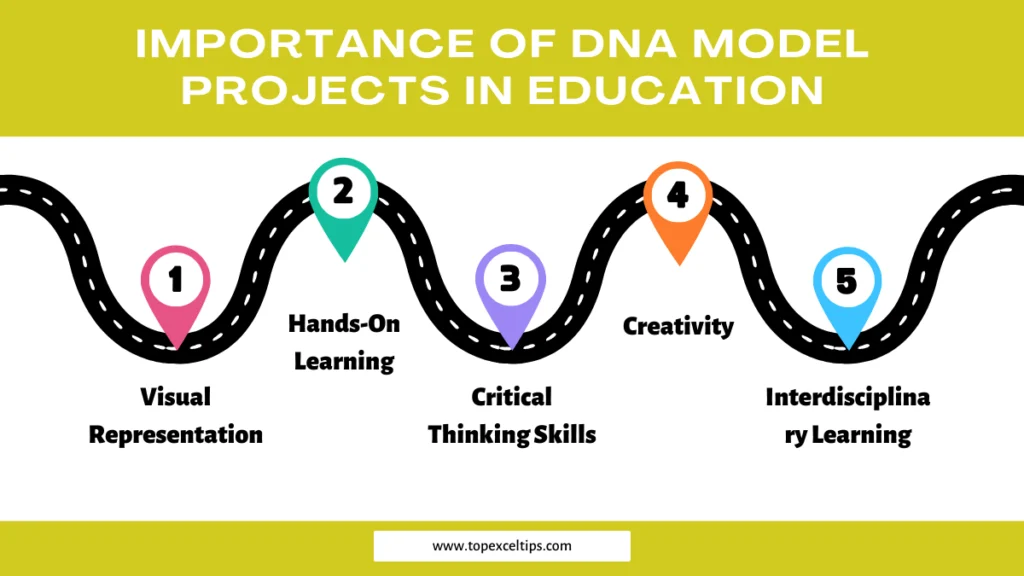
Did you know that DNA evidence has revolutionized criminal investigations, leading to countless convictions and exonerations?
DNA, the blueprint of life, holds the key to understanding our genetic makeup and unlocking mysteries within biology.
Its significance in shaping living organisms cannot be overstated. For high school students, hands-on learning experiences are invaluable, offering a deeper understanding of complex concepts.
In this blog, we will explore exciting DNA model project ideas for high school students, making biology both accessible and engaging.
From constructing 3D models to interactive demonstrations, we’ll dive into creative ways to unravel the secrets of DNA and inspire the next generation of scientists.
DNA Model: What It Is?
A DNA model is a physical representation of the structure of DNA, the molecule that carries genetic information in living organisms.
Typically, DNA models depict the double helix structure composed of two intertwined strands made up of nucleotides.
These nucleotides consist of a sugar-phosphate backbone and nitrogenous bases (adenine, thymine, cytosine, and guanine) arranged in a specific sequence.
DNA models can vary in complexity, ranging from simple paper or pipe cleaner models to more intricate three-dimensional representations.
They serve as educational tools to help visualize the molecular structure of DNA and understand its role in heredity and biological processes.
| Also Read: CAS Project Ideas |
Best DNA Model Project Ideas for High School Students
DNA model projects are excellent ways for high school students to learn about molecular biology and genetics in a hands-on, visual manner. Here are some creative and engaging DNA model project ideas for high school students:

1. Paper Strip DNA Model
Create a simple DNA model using differently colored paper strips to represent nucleotides. Students can cut and label the strips to illustrate the pairing of complementary bases, showcasing the double helix structure.
2. Edible DNA Model
Use candy or food items to build a delicious DNA model. Students can use licorice for the sugar-phosphate backbone and various candies for the nitrogenous bases, offering a tasty and memorable way to learn about DNA structure.
3. 3D Printed DNA Model
Utilize 3D printing technology to construct a detailed, three-dimensional model of DNA. Students can design and print their models, exploring the intricacies of DNA structure and gaining hands-on experience with modern fabrication techniques.
4. DNA Origami
Engage students in the art of origami by challenging them to create a DNA model using paper folding techniques. This project fosters creativity while reinforcing the concepts of base pairing and double helix formation in a visually appealing manner.
5. DNA Extraction Experiment
Provide students with the opportunity to extract DNA from strawberries or other fruits using household materials. This hands-on experiment allows students to observe DNA firsthand and learn about the isolation process, reinforcing their understanding of DNA structure.
6. DNA Jewelry
Encourage students to design and create jewelry inspired by DNA structure. Using beads or wire, students can construct bracelets or necklaces that mimic the double helix pattern, merging art and science in a unique and wearable form.
7. DNA Model Animation
Challenge students to create an animated video depicting DNA replication or transcription. Using animation software or stop-motion techniques, students can illustrate molecular processes, gaining a deeper understanding of DNA function through multimedia exploration.
8. Recycled Materials DNA Model
Foster environmental awareness by tasking students with building DNA models using recycled materials such as cardboard tubes, bottle caps, or wire. This project encourages creativity while promoting sustainability and resourcefulness in scientific endeavors.
9. DNA Model Board Game
Inspire friendly competition with a DNA-themed board game designed by students. Players can navigate through different molecular processes, answering questions and solving challenges related to DNA structure and function while having fun with friends.
10. DNA Model Exhibition
Culminate the learning experience with a DNA model exhibition where students showcase their projects to peers and parents. This event celebrates creativity and scientific understanding, allowing students to share their knowledge and passion for DNA with the community.
11. DNA Mobile
Task students with creating a hanging mobile that represents the components of DNA. By suspending different shapes and colors from strings or wire, students can illustrate the structure of DNA and its chemical composition, adding a dynamic element to their models.
12. DNA Comic Strip
Encourage students to craft a comic strip that tells the story of DNA replication or protein synthesis. Through illustrations and captions, students can depict molecular processes in a visually engaging format, making complex concepts more accessible and entertaining.
13. DNA Model Puzzle
Challenge students to design and construct a puzzle that reveals a DNA structure when assembled correctly. By piecing together nucleotide sequences or structural components, students reinforce their understanding of DNA while enjoying a hands-on puzzle-solving experience.
14. DNA Model Song or Rap
Tap into students’ musical talents by inviting them to compose a song or rap about DNA structure and function. Through catchy lyrics and rhythm, students can convey key concepts and vocabulary, transforming learning into a memorable and enjoyable experience.
15. DNA Model T-shirt
Merge fashion and science by having students design T-shirts featuring DNA-inspired artwork or slogans. Using fabric markers or paint, students can create wearable art that showcases their understanding of DNA structure and biology in a creative and personalized way.
16. DNA Model Virtual Reality Experience
Explore the world of DNA in virtual reality by having students design immersive experiences using VR technology. Through interactive simulations, students can navigate through DNA molecules, exploring their structure and function in a captivating virtual environment.
17. DNA Model Podcast
Encourage students to produce a podcast episode discussing various aspects of DNA, from its discovery to its role in genetics and biotechnology. Through interviews, discussions, and storytelling, students can communicate complex scientific concepts in an engaging and accessible format.
| Also Read: Mechanical Engineering Research Topics |
Importance of DNA Model Projects In Education
DNA model projects play a crucial role in education for several reasons:

Visual Representation
DNA model projects provide students with a tangible representation of abstract concepts, making complex biological processes like DNA replication and protein synthesis easier to understand.
Hands-On Learning
Engaging in hands-on activities fosters active learning and enhances retention of information, allowing students to experience scientific principles firsthand.
Critical Thinking Skills
Building DNA models requires problem-solving and critical thinking skills as students navigate the complexities of molecular structure and function.
Creativity
DNA model projects encourage creativity as students explore different materials and techniques to represent DNA in unique ways.
Interdisciplinary Learning
DNA model projects integrate various disciplines, such as biology, chemistry, and art, promoting a holistic understanding of scientific concepts.
Resources for DNA Model Project ideas for High School Students
Here are some resources that high school students can utilize for their DNA model projects:
1. Online Tutorials
Websites like Khan Academy and YouTube offer comprehensive tutorials on building DNA models using various materials and techniques, catering to different learning styles and skill levels.
2. Science Supply Stores
Local or online science supply stores provide kits and materials specifically designed for DNA model projects, including pre-made components and detailed instructions for assembly.
3. School Laboratories
High school science labs often have basic materials like pipe cleaners, foam balls, and colored beads that can be used to construct simple DNA models, providing easy access for students to start their projects.
4. Library Books
Libraries offer a wealth of resources, including books and magazines with step-by-step guides and illustrations for creating DNA models, making them valuable sources of inspiration and information.
5. Educational Websites
Websites dedicated to science education, such as National Geographic and Science Buddies, offer project ideas, materials lists, and tips for conducting DNA model projects, supporting students throughout their learning journey.
Final Thoughts
DNA model project ideas for high school students offer an engaging and interdisciplinary approach to learning about the fundamental molecules of life.
Through hands-on activities like constructing 3D models, designing edible replicas, or creating animations, students not only deepen their understanding of DNA structure and function but also develop critical thinking, problem-solving, and creative skills.
These projects foster a sense of curiosity and excitement about molecular biology, empowering students to explore scientific concepts in a meaningful and memorable way.
By integrating art, technology, and hands-on experimentation, DNA model projects enrich the educational experience, preparing students for future scientific endeavors and inspiring a lifelong appreciation for the wonders of biology.
FAQs (Frequently Asked Questions)
1. Can I use alternative materials for constructing DNA models?
Absolutely! DNA model projects are highly customizable, so feel free to experiment with different materials to suit your preferences and resources.
2. Are DNA model projects suitable for all grade levels?
While DNA model projects are commonly associated with high school biology, they can be adapted for various grade levels with appropriate modifications and supervision.
3. How can I incorporate DNA model projects into my curriculum?
Consider integrating DNA model projects into lessons on genetics, evolution, or biotechnology to reinforce key concepts and engage students in hands-on learning.


